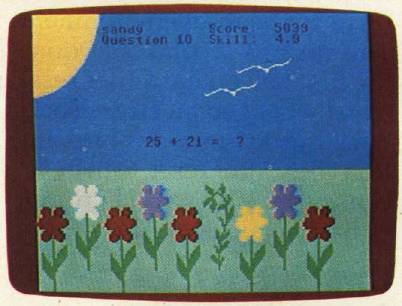Flower Power Math Fun
Tony Roberts, Assistant Managing Editor
Flower Power Math Fun is an attractive, challenging math drill game that adapts itself to the abilities of the player.
The program includes exercises with whole numbers, fractions, and decimals, and it allows the player to choose addition, subtraction, multiplication, or division problems. A decimal-fraction conversion exercise is also included. The range of the game makes it effective for a child just learning math concepts, and challenging to an adult wishing to refine his ability to solve problems in his head.
The program automatically keeps track of each user's progress, with room for about 100 files on the disk, giving it added value in a classroom situation.

Planting The Garden
Each time a student runs the program, he is asked for his name. Let's say James is playing the game. After he types his name, the program searches the disk to see if any information about James is available. If so, the screen will ask, "Are you the same James who played before?" If the answer is yes, the computer recalls the information about James's past experiences with Flower Power Math Fun. If this particular James hadn't played before, the computer would ask him to select a unique name for purposes of the program.
Perhaps Jim, or James D.
Then it's time to choose the type of problems to solve, and the game begins. The object is to fill the garden at the bottom of the screen with flowers by answering math problems correctly. A flower sprouts if the answer is correct. If the answer is wrong, a weed shoots up, and the student is given two more chances to answer correctly. If the correct answer is supplied, the weed is replaced by a flower and the game continues. If each of the three tries is incorrect, the weed remains in the garden.
There is room in the garden for ten plants – flowers or weeds. Once the garden is full, the exercise is over, and the student is given the option of playing again.
Keeping Track Of Skill Levels
The first time each of the 13 games is played, the computer sets the skill level at 1.0. If problems are solved quickly and correctly, the skill level is increased and the problems become more difficult. When a student answers incorrectly, the skill level decreases. Through this method, the program keeps a student of any level working at the edge of his capabilities.
The program also awards points for correct answers, based on the time it takes to provide the right answer. Nothing is subtracted for a wrong answer, and nothing is added for an answer that is too long in coming.
At the end of each session, the student's skill level and score are saved on disk. The next time he plays, he'll be able to pick up where he left off.
The program requires precise answers. For example, if a fraction addition exercise had produced the problem 3/8 + 3/8, the computer would not accept an answer of 6/8. The program would prompt the player: "Reduce your fraction."
Unemotional Graphics
Flower Power Math Fun is not an arcade game. Aside from the garden, with its colorful flowers and green weeds, a sun, and a couple of birds in the sky, nothing flashy has been designed into the program. Officials at Softwave Productions use the word "unemotional" to describe Flower Power Math Fun's graphics. "It's enough to keep them interested, but not enough to distract them."
There is no music, and there are no explosions to disturb others in a classroom. The only sound produced by the program is a series of notes which slide up on a right answer, down on a wrong answer.
A session with the program could last as long as time permits. If several students hope to have their chance to play, a student could complete one exercise in about five minutes.
The instructions that come with the program are sparse, but little guidance is needed. A report program included with the game allows a teacher to review the progress of each student either on screen or via a printout. The information available to the teacher includes the student's name, skill level, and high score for each of the 13 exercises. In addition, the report program can be used to erase one or all records from the disk.
A Challenge For All
The package describes the game as fun for ages 5–15. A five-year-old would be able to handle many of the problems at lower skill levels, and the higher levels can present a challenge to older players, even those far past the age of 15. The problems at the higher levels of the whole number addition exercise, for example, have you adding 8-and 9-digit numbers without using pencil and paper.
Using Flower Power Math Fun regularly, for even just a short time, would sharpen almost anyone's ability to solve math problems mentally. This is not the kind of game that will keep kids riveted to the keyboard during all their after-school hours, but it can satisfy and challenge computer-loving kids in the more sedate setting of a schoolroom.
Flower Power Math Fun is available for the Commodore 64 and Apple II computers.
Flower Power Math Fun
Softwave Productions
156 Drakes Lane
Summertown, TN 38483
(615)964–3573
$39.95